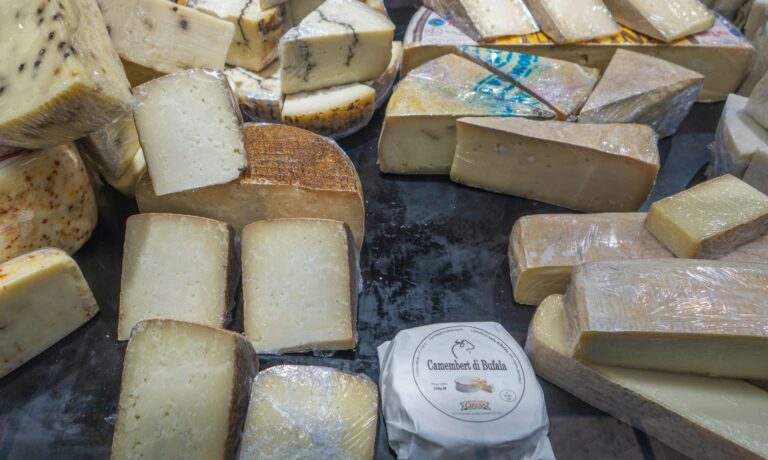According to a scientific study from 1984, over 90% of the Chinese adult population is lactose intolerant. In this context, one would think that there is no space for the cheese market in China. However, more and more can be found in the fresh food aisle of Beijing, Shanghai or Guangzhou’s stores. But be careful: this type of cheese is far from the French one. To seduce Chinese taste buds, foreign producers bet successfully on processed cheese.
Cheese market in China: Processed cheese is preferred to natural cheese for its mild flavor
Given the lactose intolerance of a broad majority of the Chinese population, milk products, and especially cheese, are practically absent from Chinese traditional food. Because of its strong taste and the fabrication process that can be surprising for people who do not know cheese, French cheese appears all the more exotic and strange to Chinese consumers. Generally speaking, natural cheeses which are obtained by milk fermentation or curdling are the most difficult to commercialize in China.
On the other side, processed cheese is more popular. It is the result of melting and mixing different natural cheeses together with oil and food additives. Gouda, cheddar or mozzarella belong to this category of cheese characterized by its lightened taste and its ease of use. Chinese people consume such cheese on bread or crackers for breakfast, or as snacks.
Packed, sliced or sold in block: products’ packaging plays a role in purchase decisions
In most cases, those processed cheese are presented pre-packed and sliced or in a block. The latter represent 50% of the market, followed by sliced cheeses that are used in burgers and sandwiches, and finally creamy cheese, according to a study from the BBC.
Enthusiasm is such that the second player of the cheese market in China, the Neo Zealand group Fonterra, invested some 170 million dollars within one and a half year to double its production of mozzarella, creamy cheese, and sliced processed cheese, Fonterra’s leader, explains to the China Daily.
The cheese’s two trump cards: recalling Western way of life and promising health benefits
The popularity of some cheeses in China is often related to their use. The success of mozzarella over products like Blue cheese or Camembert, for instance, can be explained by the fact that it is frequently used in pizzas. And pizza is precisely a dish that is becoming more popular among Chinese people who are influenced by Western food habits. The same goes for cheddar or Gouda which are used in hamburgers and other fast-food products, at a time of expansion of fast-foods in the country’s biggest cities. Indeed, a significant part of Chinese people discovered cheese by eating a slice of pizza. And they wish to repeat the experience as soon as they consume Western food because cheese can hardly be cooked with traditional Chinese dishes.
Besides, cheese is increasingly seen as a healthy product that can supplement potential lactose deficiency, especially among children. Since the scandal of Sanlu milk adulterated with melanin in 2008, Chinese people are very careful to the quality of the milk products they consume. They turn to famous Western brands that communicate on the health benefits of their high-calcium and -protein products. It is, therefore, those types of cheese that are the best positioned to convince Chinese consumers.
A majority of cheeses is imported, but very few come to France
As a proof of Chinese people’s appetite for processed cheese, this market has known a constant growth over the last few years and should keep expanding shortly: according to Euromonitor, the average annual growth rate of processed cheese sales for the period 2014-2018 is around 16.49%.
If the Chinese food industry leader Bright Dairy & Food was dominating the cheese market by controlling half its shares in 2012, 94% of consumed cheese in 2014 was imported, the China Daily reports. A majority of products (80%) comes from New-Zealand, Australia, and the United-States which were the first to understand which type of cheese Chinese people like.
On the contrary, French exportations represent only 4% of cheese imported from China. However, Bel Group generates a respectable turnover with brands like “Mini babybel” and “Kiri” for instance – whereas its famous “Vache qui rit” suffers from the direct competition of the brand “Happy Cow” .
Could natural cheese be more popular in the coming years?
Despite the preference of Chinese people for processed cheese, the smaller natural cheese market is going through a stronger growth. According to Euromonitor, the sales on this market could increase at the rhythm of 17.6% per year over the 2014-2018 period.
Liu Yang, French cheese lover and founder of the shop “Le Fromager de Pékin,” noticed this trend: while his first clients were mostly foreigners in 2009, his offer is today attracting a majority of Chinese people, he tells the BBC. For instance, they are seduced by his “Beijing gray” Camembert, his Tomme or his local Blue cheese. Are those cheeses on the way to replace mozzarella and Gouda on the podium of Chinese people’s favorite cheeses?
Daxue Consulting’s related project: Online survey on cheese consumption
Our client is a UK-based consultancy specializing in marketing research and consultancy in the international agribusiness and food & beverage sectors, with a particular focus on the global dairy market. The company approached our team to conduct a Usage, Attitude, Image (UAI) study for one of its clients that wished to enter the Chinese market with a new product. Daxue Consulting provided an output for a total of 2,000 participants who regularly consume cheese, from the following cities (equal distribution between cities): Shanghai, Guangzhou, Beijing, Chengdu, and Chongqing. The survey questionnaire respondents preferences regarding taste, packaging, brands, top countries in term of reputation of providing high-quality cheese products, shopping habits, etc.
Stay Up-to-date. Follow us on Facebook:





